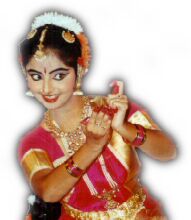skip to main |
skip to sidebar

An ancient traditional art form with its origins steeped in divinity, Bharata Natyam reflects the culture of India at its best.
The performer (male or female) is usually a soloist accompanied by a minimum of two musicians and usually four for a full-scale concert. The dancer uses the space as her own sacred temple and brings the audience into her magical circle as she performs and acts out stories with Gods and Goddesses from Indian mythology, folk tales and stories with emotional content. Being a living art form it has continued to enrichen itself changing with the times yet keeping its pristine beauty and nature intact. Linear geometrical patterns, a perfect balance of the body, eloquents of expression, and precision of footwork to intricate mathematical rhythms are the hallmarks of this dance.
The dance originated 5000 years ago and comprises of several arts like sculpture, painting, theatre, literature, music, dramaturgy, and poetry. Young girls were dedicated to the temples at the early age of eight years where they underwent a strict discipline in the above related arts to fully understand, comprehend and evoke the sentiments required of them as dancers. Their tutelage was conducted under eminent performers of the arts who were either the established temple dancers known as “Devadasis” (Servants of the Gods) or ‘Rajadasis’ those who were the courtesans of the state and kingdom. The art form originated in the southern part of India in the state of Tamil Nadu and flourished greatly under the patronage of several kings some of whom were composers of the poetry and musical compositions that the dancers performed to and have handed down this rich tradition by word of mouth.
The dance itself is divided into two categories, which are the pure dance ‘NRTTA’ and the expressional dance ‘NRITYA’. In the pure dance abstract patterns are woven to complex rhythmic pattern played by the drummer. The dancer and drummer synchronize and create geometrical patterns with precision as the vocalist sings to a separate time measure yet all performers almost seeming to be at their own different time measures conclude simultaneously. Within a framework of basic 35 time measures several more are created. The dance is sculpturesque and the art of iconography comes to life as one witnesses in the hands of a proficient performer the limitless dimensions of this highly venerated art form. The dance is flourishing in its country of origin and has a large following amongst those initiated to its intricacies and cultural concepts. Performers have become virtual cultural ambassadors of India representing its cultural heritage at its best.




0 comments:
Post a Comment